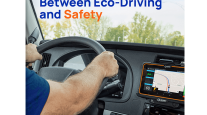Self-Driving Truck Technology Advances
By Stephen Bennett, Contributing Writer
This story appears in the May 18 print edition of iTECH
While self-driving trucks may still seem like a concept that is several years from becoming reality, using wireless communications to connect commercial trucks with each other and signals from the infrastructure may be just around the corner. It’s not yet known whether federal regulators will call for wireless communications among commercial trucks, but they have done so for light vehicles, with the goal of enhancing safety.
Connected vehicles and truck platooning have been demonstrated in several venues, including real-life situations, but before they can be deployed, companies and officials must sort out some thorny issues.
One issue is use of a slice of radio spectrum called dedicated short-range communications that has been reserved for coordinating safety applications between vehicles in what is often called “V2V” communications, meaning vehicle-to-vehicle. Wireless service providers have been pushing to use that same radio frequency.
The National Highway Traffic Safety Administration said in an e-mail to iTECH that it “believes strongly in the potential of V2V to achieve important safety improvements” and that it is aiming to complete work on “a wide range of V2V-related rulemaking efforts as quickly as possible.”
Some in trucking said that they expect NHTSA to announce a decision regarding commercial trucks and V2V this year.
“I would expect most likely sometime after September, we’ll see an announcement,” said Ted Scott, director of engineering for American Trucking Associations. But he said he didn’t know what NHTSA would announce. “Whether or not we’ll see our own advance notice of proposed rulemaking” — a rulemaking for heavy trucks similar to that for light vehicles — “I can’t say.”
Debra Bezzina, senior program manager at the University of Michigan Transportation Research Institute, said that a “commercial truck announcement was intended to be made in 2014, so we should expect something relatively soon.” Rulemaking processes include extensive gathering of information, analysis and periods for public comment and can take a number of years to be completed.
NHTSA said that the date when DSRC-equipped trucks might appear on U.S. highways was “uncertain.” Asked what capabilities connected tractor-trailers might be likely to have, the agency said it anticipated that V2V technology initially will enable trucks to send and receive a basic safety message, or BSM, at a rate of 10 times per second. The messages will allow trucks to have “precise situational awareness” of vehicles nearby, making possible a range of safety and mobility applications, the agency said.
OEMs could utilize vehicle-sensing capability to implement many of the same V2V safety applications as those being developed on light vehicles, NHTSA said, including blind-spot monitoring and the issuing of warnings, for example, at intersections when systems detect a high probability of a collision. In another application, a vehicle engaged in emergency braking would send a message to a nearby vehicle.
But there is a deployment challenge for both light and heavy vehicles to use connected vehicle technology, NHTSA said. It is the establishment of a security system to authenticate messages between vehicles. A security credential management system — known as SCMS — is needed “to deliver, monitor, revoke and manage security certificates used by vehicles to establish authenticity and integrity of the messages they send and receive — while at the same time protecting privacy,” the agency said.
The Department of Transportation has been working with the auto industry and other private-sector partners to develop a suitable SCMS and is building a prototype that will be used in vehicle development and demonstration activities, the agency said. “In the long run, NHTSA envisions the SCMS to be a privately run, funded and self-governing entity — with an appropriate government oversight role,” NHTSA said. Establishing a sustainable SCMS operation represents “an important challenge” for connected vehicles, the agency said.
In addition, the articulated nature of tractor-trailers represents a special challenge. NHTSA said a BSM must convey an accurate description of location, speed, heading and “footprint” of the tractor-trailer so that receiving vehicles can determine potential safety threats. The high level of accuracy is needed because the footprint of the tractor-trailer is dynamically changing during turning maneuvers. DOT is developing and evaluating alternative approaches designed to enable articulated tractor-trailers to send an appropriately detailed message, NHTSA said.
Scott of ATA said capturing and conveying the dimensions and movement of tractors with varying wheelbases and trailers of varying lengths as they proceed through turns is “almost rocket science.”
In the meantime, research and development also is being conducted on DSRC-enabled vehicle-to-infrastructure — V2I — communications by government, manufacturers, academics and organizations. Examples of V2I applications are “cooperative” collision avoidance at intersections, curve speed warnings, low-bridge height warnings and work zone warnings, NHTSA said. Another potential application would switch a traffic light from red to green in a case where a vehicle was stopped with no other traffic around.
A two-year UMTRI research project that ended in August deployed more than 2,800 vehicles, including 19 tractor-trailers equipped with DSRC devices and safety applications, Bezzina said. The project also involved 57 medium- and heavy-duty commercial vehicles equipped only with “Here I Am” devices, also known as vehicle awareness devices, that transmitted their GPS location, speed and heading, Bezzina said. They served as “seed vehicles” to increase interactions between equipped vehicles, she said.
In addition, a 32-acre “mini-city” designed for testing connected and automated vehicle systems, as well as other “smart city” technologies, is scheduled to open July 20 on the University of Michigan’s North Campus, Bezzina said. Called “M City, it will include four lane-miles of roads with intersections, roundabouts, roadway markings, traffic signs and signals, sidewalks, bus facilities, benches, simulated buildings, streetlights, parked cars, pedestrians and obstacles such as construction barriers.
Though DSRC is the basis of the research and development of connected-vehicle technology, the Federal Communications Commission has asked technical experts to review the feasibility of sharing it for other applications besides safety communications. It has been 16 years since FCC granted the slice of spectrum — 75 MHz of bandwidth at 5.9 GHz — exclusively for safety and mobility applications. Wi-Fi use has exploded in recent years, and Wi-Fi communications firms, seeking more bandwidth, are lobbying to be allowed to use DSRC.
That has raised concerns that safety messages could be disrupted.
“Until they can tell us that there will not be a degradation, we think we ought to stay with a dedicated system,” ATA’s Scott said. FCC asked experts to provide a report with recommendations to consider before the agency makes a decision on sharing.
One option would be to rely on Wi-Fi chips to sense DSRC devices in vehicles and get off the air; another would be for the DSRC community to modify its band plan to make it easier to tweak current Wi-Fi designs and enable “coexistence,” said Jim Lansford, chairman of a committee within the Institute of Electrical and Electronics Engineers, a standards-setting and professional organization in New York that studied the matter for FCC.
Lansford said in April that the IEEE committee had finished its work, but “the report itself doesn’t actually make any specific recommendations because we ended up not coming to any consensus.” The report was circulating within IEEE, Lansford said, and he thought it likely that IEEE officials would make a statement “of some sort” in mid-May.?Meanwhile, equipment manufacturers are engaged in developing V2V systems based on DSRC. Peterbilt Motors Co., in Denton, Texas; Meritor Wabco, of Troy, Michigan; and the Federal Highway Administration participated in tests in April at Auburn University, in Auburn, Alabama, of two-truck “platooning” that depends on integrating vehicle-to-vehicle communications and adaptive cruise control. The system, being developed by Peloton Technology, based in Mountain View, California, combines radar and DSRC communications to synchronize acceleration and braking between two tractor-trailers.
“There’s a safety improvement that comes with collision avoidance systems,” said Josh Switkes, CEO of Peloton. “We extend that to a pair of trucks through the platooning system, through DSRC.” If DSRC were to be shared, he added, it would not affect the platooning capability of the system his company is developing.
Peloton announced in April that it had received $16 million in new funding to develop its system from Denso International America, of Southfield, Michigan; Intel Capital, a division of Intel Corp., based in Santa Clara, California; Volvo Group Venture Capital, part of Volvo Group, of Gothenburg, Sweden; and UPS Strategic Enterprise Fund, part of Atlanta-based UPS Inc.
Peloton also said it was developing a “Platooning Network Operations Center,” which it described as a cloud-based service that would communicate with trucks “to approve and adjust platooning parameters based on location, road and weather conditions.” It also will help trucks find platooning partners, the company said.




